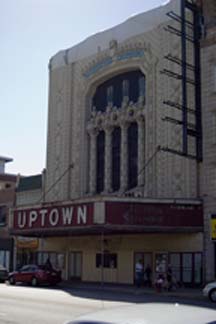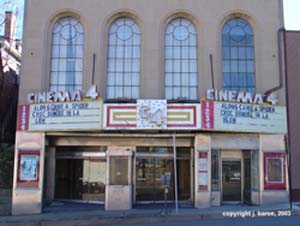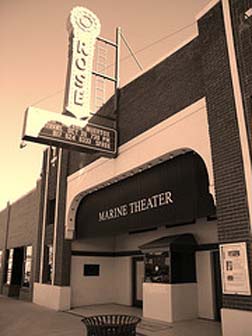

America has a long tradition of building theaters.
It dates back to 1716, when the first recorded theater was built in Williamsburg, VA. By the 1770s, Boston, New York, Philadelphia, and Charleston, SC – the settled east coast – all had theaters where resident and travelling theater companies performed.As the country grew, so did the number of theaters.
.Many of them were built to house vaudeville, which entertained the country from the 1880s through the 1930s. Made up of variety acts and presented by the Keith-Albee and Orpheum circuits, vaudeville preceded film and was a training ground for many of its early performers. In large cities and small towns, in grandiose buildings and rough-hewn structures, Americans saw peformers before their screen debuts -- the Marx Brothers, the Three Stooges, Bob Hope, Judy Garland, and many others.America's theaters were adapting to the changing times.
Film was introduced around the turn of the centry -- that's the 20th century!. Vaudeville acts were now accompanied by silent movies projected to live piano accompaniment. Sound film arrived in 1915 and these "talkies" led the way for the true movie palaces."Palatial" truly describes these theaters built during the prosperous 1920s, prior to the Great Depression.
The architecture reflected the full-blown sense of fantasy that movie patrons could enjoy. Moorish. Egyptian. Oriental. Opulent as the grand palaces of Europe. Or streamlined in the popular Art Deco style. These theaters were established as chains and owned by the major film studios of the day -- Parmount, Warner Bros., Lowes, Fox, and RKO. In 1946, an estimated 90 million people a week attended the movies. Vaudeville was gone, but now movies provided year-around entertainment, as the movie palaces were one of the first public places to have air-conditioning.By the 1950s, the picture literally changed again.
Television arrived and the post World War II suburban building boom brought fewer move-goers to theaters, which were often located downtown. Another factor in the theaters'demise was the 1948 Supreme Court decision which forced the studio owners to divest their holdings. With attendance down and no studio bankroll to maintain them, these beautiful theaters were gradually demolished or became neglected eyesores.
Theatre Historical Society of America
By the time it closed in 2001, Pittsburgh's South Hills Theatre was on its way to becoming such an eyesore – a far cry from its days as the country's first nickelodeon theater.
Built in the late 1920s, the South Hills hosted five-cent movies and vaudeville acts for Pittsburgh's Dormont neighborhood. As movies ecliped vaudevile, the South Hills ran first-run and later “B” movies – Westerns and low-budget sci-fi and horror flicks. It was kept alive through the 70s and 80s as a rock-concert venue, but by the 90s had become a victim of the mega-screen mentality and was re-named “Cinema 4”. Left to stand with a partially dismantaled marquee, it had been closed for about 8 years when Rick Fosbrink started a grass-roots effort to acquire and restore the landmark South Hills.

Chicago's Uptown Theatre hasn't been so fortunate. Everything about this ornate, 4381-seat theater on the city's North Side is big...including the big-time neglect it's experienced for the last 20 years.
The Uptown Theater opened in 1925 with fanfare in keeping with its size and grandeur. Owned by movie magnates Balaban and Katz, it was built in the Spanish Revival style by the firm of Rapp and Rapp. Known for their work on other large movie palaces, the architects had created the UpTown with a five-story entrance lobby and an eight-story facade. With its three massive lobbies, it was the largest movie palace ever built in the United States prior to Radio City Music Hall, which opened in 1932.
Everything about the UpTown Theatre was top-drawer.
Other theatres had vaudeville acts before the movie, but a live show at the UpTown had a theme in keeping with the movie. Not to mention the 34-piece orchestra that accompanied the live entertainment! Newspapers of the day wrote that the UpTown and four other Chicago theaters by Rapp and Rapp had been “built for all time.” During the 1940s the stage was only used occasionally, but the movies continued through the 50s and 60s. By the late 60s, both movie audiences and the UpTown retail area had slumped. During the 70s, drawing on its cavernous size, the UpTown drew crowds for performances by the Grateful Dead, Bruce Springsteen, Prince, and other rock stars.
Will the UpTown be a theater “built for all time” or Chicago's sad white elephant?
1981 may have marked the end for the UpTown. Rentals had been sporadic. Maintenance was increasingly haphazard. When a pipe burst due to lack of heat, the Uptown was closed. Its exterior has since been vandalized. The good news is that in 1991 the Uptown Theatre was declared a Chicago Landmark and placed on the National Registrar of Historic Places. The bad news is that the UpTown has had several owners over these two decades. While local advocacy and fund-raising continues, the UpTown's future remains in question.

Sometimes a theater provides more than entertainment. It can keep a culture alive. It can give a community a sense of place.
That's what the renovated Rose Marine Theatre is doing for the Hispanic community of Fort Worth, TX. Since it opened in 1918 as a movie house, this 500-seat theater has been known as the Rose, the Roseland, and the Marine Theater. While every theater has a story to tell, the Rose Marine's legacy is especially interesting. During the segregated 1940s and 50s, the Rose brought in Spanish-speaking films and entertainers. In recent years members of the Hispanic community who remember those Saturday nights at the movies have worked with the city of Fort Worth to revitalize the Rose.